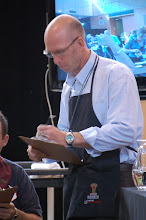Upon further reflection I've decided that declaring something as acceptable/unacceptable is not appropriate since:
- acceptable does not adequately describe perfection in any or all elements
- the spectrum of acceptable may be mathematically described by a differential equation and therefore assigning even 2 extra descriptors to each of the 5 M's plus Water is not unreasonable.
- unacceptable is clearly definable, and once the threshold is crossed, the degrees of unacceptability is moot.
Therefore, what I am proposing is to assign two further designations to each of the 5 M's plus Water that reflect acceptable faults which individually do not fatally flaw the espresso.
For example:
- Grind
- Perfect
- Too course but acceptable
- Too fine but acceptable
- unacceptable
- Water
- Perfect
- Too Soft but acceptable
- Too Hard but acceptable
- unacceptable
- Blend
- Perfect
- Too fruity but acceptable
- Too flat but acceptable
- unacceptable
The others can be fleshed out and debated as to what would adequately describe acceptable opposing variables, but I believe including two extra designations is a better reflection of the possible outcomes when a barista attempts to make an espresso.
If the inclusion of two extra descriptors are accepted then the new equation becomes:
4^6= 4096
This means there are 4096 possible outcomes each time a barista attempts to make an espresso.
This greatly increases the number of possibilities for espresso outcomes but I think is helpful to put in perspective how difficult it is to make a perfect espresso, and even how unlikely it is that one ever gets made. While this statement is no doubt going to raise some eyebrows, remember, that if even one of the variables is less than perfect, then necessarily the beverage is not perfect.
I'm curious to see what others think of this description of espresso and whether it is productive to think of it in these terms.



